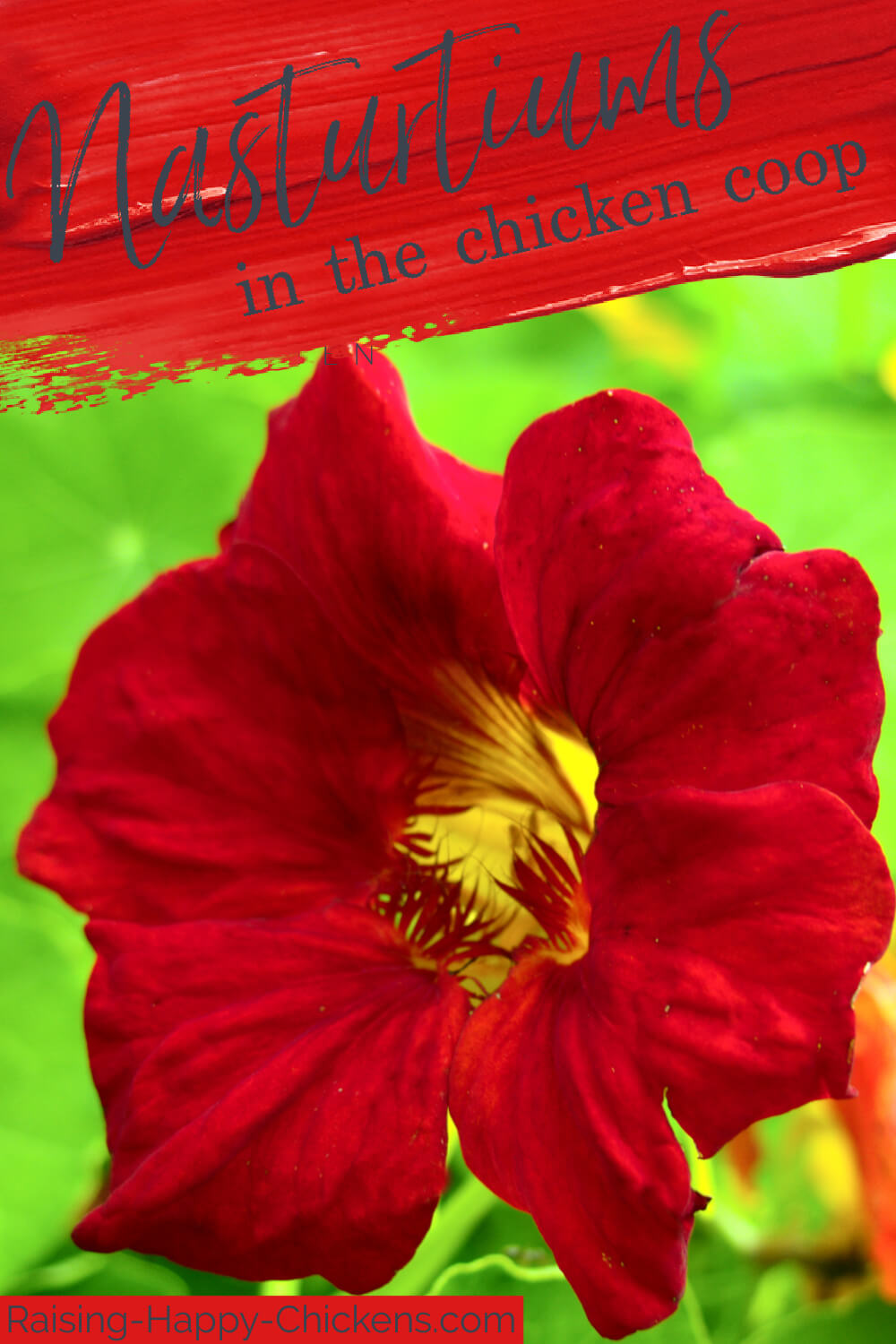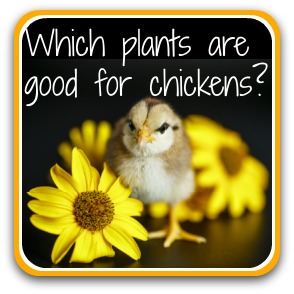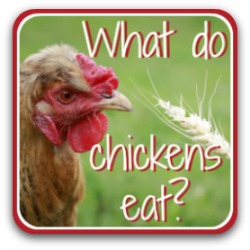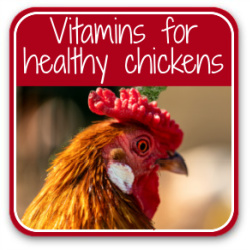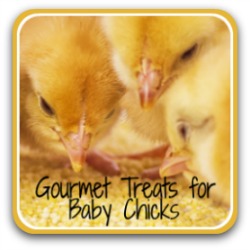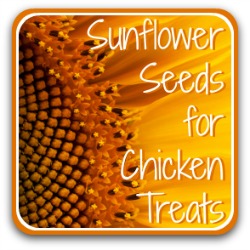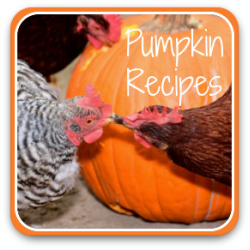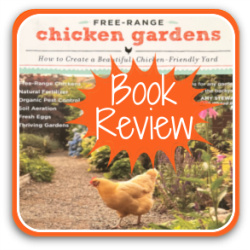- Home
- Plants for Chickens
- Nasturtiums
Nasturtiums for chickens: benefits, uses and how to grow.
Looking for an inexpensive, natural way to give your flock nutrients and add colour to your garden at the same time?
Happy news - you've found it!
For a long time, additives have been used in chicken feed to promote growth and maintain health.
But antibiotics and growth promoters have both been banned in the European Union for more than a decade, and natural alternatives have been sought.
That's led to research into natural substitutes, including plants, which can be proven to enhance a flock's health and boost the quality of their eggs, without any adverse side effects.
One such plant readily available for backyard chicken keepers is used commonly to add colour and interest to the pots and borders of many summer gardens: the nasturtium.
What is the Nasturtium?
Its botanical name is Tropaeolum majus. Don't confuse it with Nasturtium officinale - which is watercress.
Originally from south America, it's an annual plant also sometimes known as Monk's Cress or Indian Cress.
Its sprawling growth sets distinctive leaves and large, abundant, happily colourful flowers which are often red and orange - a chicken's favourite colours - sometimes joined by yellow and cream.
It's incredibly easy to grow in virtually any soil for most of the year, and the flowers will bloom from spring until first frosts.
Brightening up the gloomiest of shady corners, the nectar it produces attracts not only bees and butterflies but, if you're lucky enough to have them in your area, humming-birds.
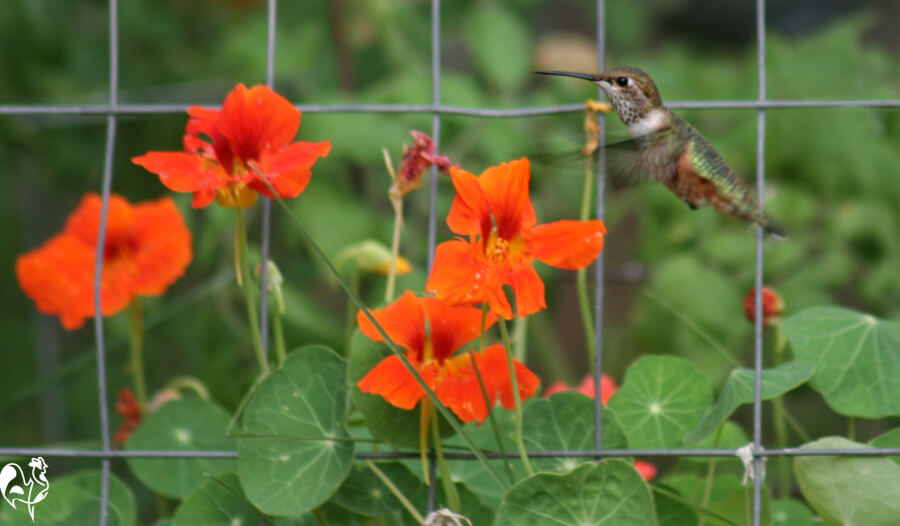
Want a quick summary of plants that are good for chickens?
Watch this video!
What benefits are claimed for nasturtiums fed to chickens?
As often happens, a lot of claims are made for the benefits of nasturtiums for chickens, most of which are either unproven or simply not true.
Some of them are that a nasturtium plant...
- is a natural antibiotic
- is a natural wormer
- gets rid of fungus
- prevents cancer and eye conditions
- cures fowl pox...
Let me say right now - there is no treatment for fowl pox. The only way to prevent the disease is through good husbandry and, if there's an outbreak, vaccination before the bird is infected(1).
To continue with the claims...
- sorts out respiratory disease
- makes hens lay more eggs
- "helps create blood cells in the chicken's body"
- helps chickens with "nervous ailments and depression".
And if you're a human with a hair problem worry not, because applying a tea made from nasturtium leaves will apparently restore hair growth, too.
How much of this is true? Not much.
Let's look at the evidenced facts.
Benefits for chickens.
Are nasturtiums a natural antibiotic?
Yes, this claim is true. It's one of the few claims that is backed by proper evidence.
In fact, several studies(e.g. 2, 5) have shown that the nasturtium is more effective than commercial antibiotics in suppressing five different types of bacteria common to chickens.
Nasturtiums as a source of essential vitamins.
Again, this claim is well evidenced (e.g. 3).
Every part of the nasturtium plant is a rich source of vitamins C and A.
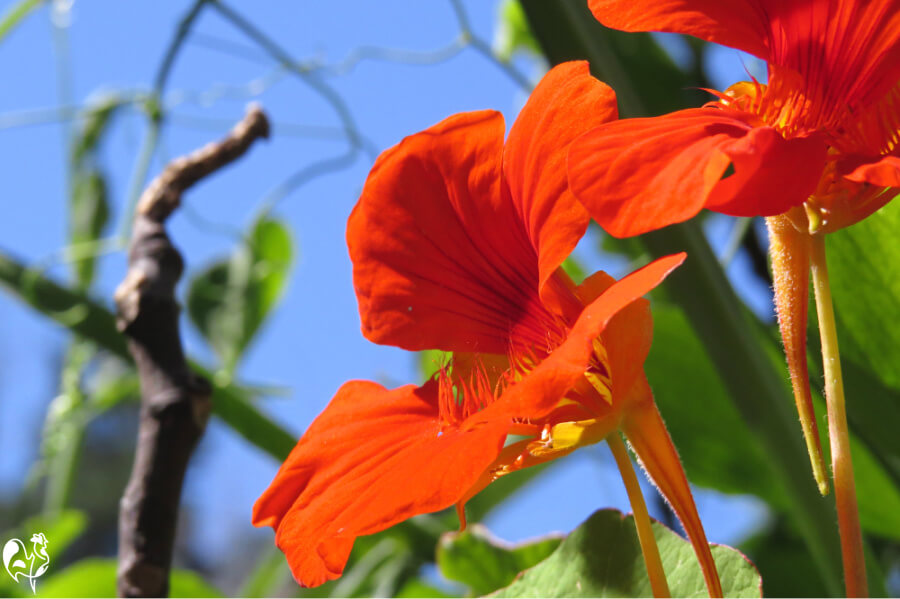 The stunning flowers are full of Vitamin C.
The stunning flowers are full of Vitamin C.- Vitamin C helps create a strong immune system in chickens.
- Vitamin A is responsible for healthy growth and bone development. Chickens are affected by a lack of vitamin A very quickly, and it can prove fatal(4).
They also contain trace elements like potassium (which helps poultry withstand heat), phosphorous (helps absorb calcium which is essential for healthy bones, particularly important for egg layers) and iron (lack of which causes anaemia in poultry).
Do nasturtiums make a chicken lay more eggs?
Physically impossible.
A chicken lays one egg approximately every 26 hours. That's how long it takes for an egg to be formed in the oviduct.
No amount of nasturtiums can make that process any faster.
Would nasturtiums mean a hen could lay eggs for longer each year?
There's no evidence of that. The only evidenced way of making hens lay for longer is by providing additional light in the coop.
There is evidence, though, that the presence of carotenoids in nasturtiums helps the egg yolk to become a darker colour, much as is the case with marigolds.
Can nasturtiums prevent cancer, eye problems, respiratory tract infections and "fungus" in chickens?
All unproven.
Nasturtiums contain a carotenoid - a type of vitamin - called Lutein. It's related to vitamin A.
There is evidence that the lutein content of nasturtiums helps prevent cancer in mice(5). But mice are not chickens.
There's also strong evidence(6) that lutein helps combat macular degeneration and cataracts, diseases of the eye, in humans.
But humans are not chickens, either.
Lutein is a beneficial substance, there's no doubt about that. And it is right that lutein can be found in chicken eggs.
So feeding your hens with the lutein nasturtiums can provide may have a beneficial effect on their eggs. And if we eat their eggs, it may have a knock-on beneficial effect for us.
But none of that is actually evidenced anywhere.
Are nasturtiums a natural wormer?
Despite statements you'll see more or less everywhere, I've been able to find absolutely no evidence of this, anywhere. There isn't even any evidence to suggest it promotes urinary tract infections of any kind in humans.
They do act as a diuretic in rats, helping them expel more water from the system - not worms. And again, chickens are not rats.
To say "my chickens eat nasturtiums and they don't have worms, therefore nasturtiums are a natural wormer" is not evidence! Chickens not having worms could be down to any number of reasons.
Practicing good husbandry, in particular keeping wild birds out of the run, is the best way to prevent your chickens getting worms.
 A swallow in the chicken house - pretty, but a potential source of worms.
A swallow in the chicken house - pretty, but a potential source of worms.As for "nervous ailments and depression"...
Chickens are naturally anxious. They're prey creatures and instinctively react to any sudden noise, or change in their environment. To say they have "nervous ailments" is to attribute human troubles which they just don't have.
The answer to their natural nervousness is not nasturtiums. It's routine, a safe place to roost, and proper protection from predators.
To summarise the benefits for chickens...
Nasturtiums are a natural antibiotic and will provide your flock with plenty of vitamins A and C, and trace elements which are beneficial to their overall health and well-being.
As long as you don't expect them to cure everything, you won't be disappointed.
Are they worth growing? Absolutely!
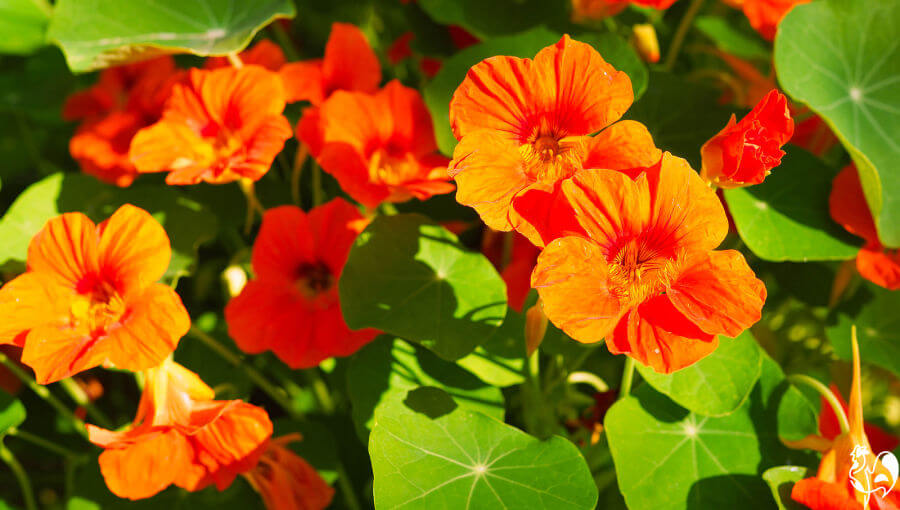 Those flowers add joy to any garden!
Those flowers add joy to any garden!Nasturtium benefits for gardens - and people!
As well as benefits for chickens, nasturtiums have definite benefits for the garden. The most beneficial of these can at first seem like a real problem.
Because nasturtiums always attract unwanted guests, particularly caterpillars and the cucumber and pumpkin beetles.
Which means you need to keep looking for the tiny eggs laid on its leaves, and the greedy caterpillar which likes nothing more than munching on its leaves and flowers.
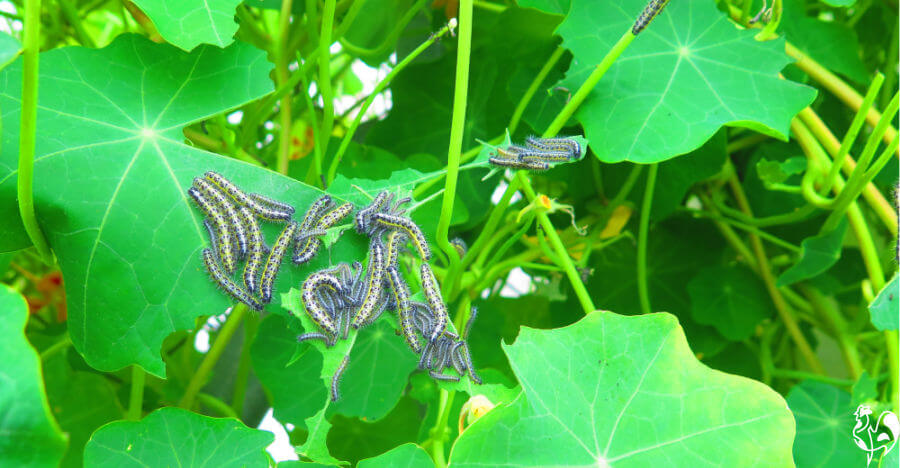 The caterpillar of the cabbage white butterfly loves munching on nasturtium leaves.
The caterpillar of the cabbage white butterfly loves munching on nasturtium leaves.But this also has advantages.
- The nasturtium is known as a "companion plant": planting it with other crops, particularly vegetables, attracts those pests away from their usual hosts which means that your nasturtiums may get eaten, but your veggie crops will stay intact.
- Remember too that its sweet nectar buried deep in the neck of the flower attracts bees, butterflies and hummingbirds, and insects like hoverflies which feed on other pests.
- Because it grows quickly and densely, it provides a good ground cover which will help keep weeds at bay.
- Of course, a stunning display of nasturtium flowers just looks wonderful, brightening up any garden, no matter how small or how poor the soil.
- And best of all? The nasturtium is edible for humans too! One of my favourite summer meals: grow them for the colour in your garden, then add their flowers and peppery leaves to smoked salmon and hard boiled egg.
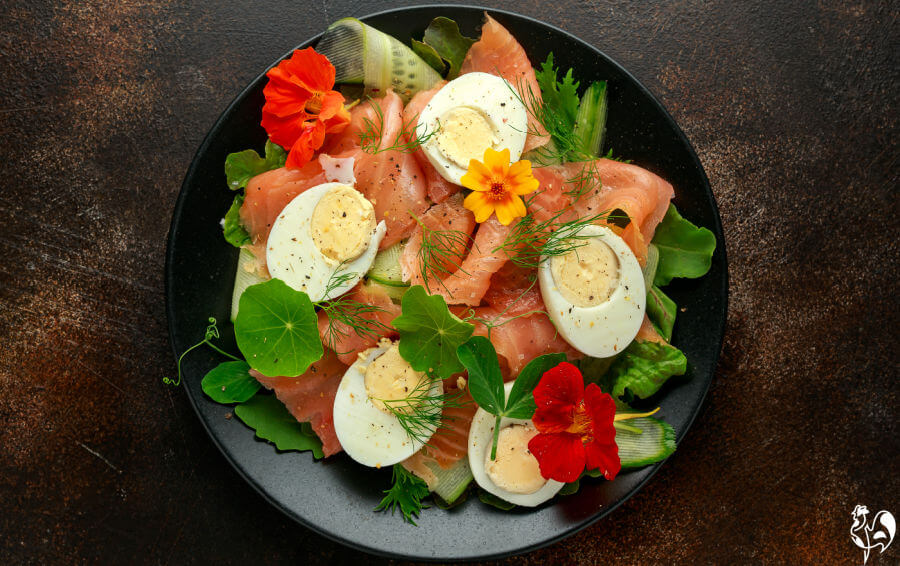 A nasturtium salad for a natural vitamin "C" boost for the family.
A nasturtium salad for a natural vitamin "C" boost for the family.Where to grow.
Nasturtiums are the perfect plant if you're not too good at constant care. They almost thrive on neglect.
- The poorer the soil the more flowers they'll produce.
- The less water they have, the better, so they're good for areas with limited rainfall.
- And they do well in either shade or sun, although extreme heat will see them wilt.
They're not keen on frost or wind, so plant in a sheltered spot but apart from that, there's nothing much to be aware of!
The climbing nasturtium.
Nasturtiums can be grown as a vine - just make sure you buy the variety that climbs. Of course, they'll need something for the tendrils to cling onto. A chain-link fence is ideal. If your fence is wood try attaching some chicken wire to act as a trellis.
Whatever you do though, don't plant nasturtiums inside the chickens' run. In my experience, they'll enjoy digging the plants up and eating them wholesale. You'll literally have nothing left.
Instead, plant outside the run, either directly into the ground or into pots. That way, the flock can reach some of the leaves and flowers but can't get to the roots.
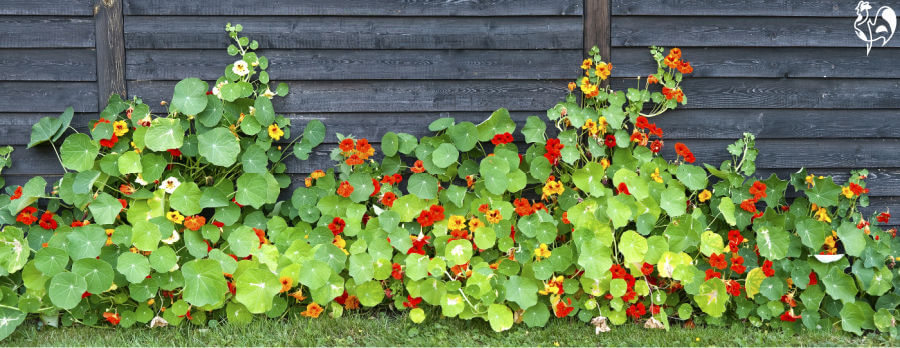 Grow nasturtiums in areas where chickens can't dig them up!
Grow nasturtiums in areas where chickens can't dig them up!Nasturtiums in hanging baskets or window boxes.
Climbing nasturtiums which don't have something to cling to will creep or trail nicely, which is a bonus if you want to use them in hanging baskets, or as part of a colourful and useful "edible garden" in your coop's window box.
Try "Jewel Mix" which gives a lovely combination of red, orange and yellow flowers.
Nasturtiums in planters and as ground cover.
The compact varieties - Empress of India is a big favourite - do well in containers and borders. They grow very quickly, so they're ideal for hiding untidy ground in very little time.
This "caterpillar planter" made of used tyres packed with compact nasturtiums looks lovely, but again, chickens will dig those plants up in seconds if it's placed anywhere they have access!
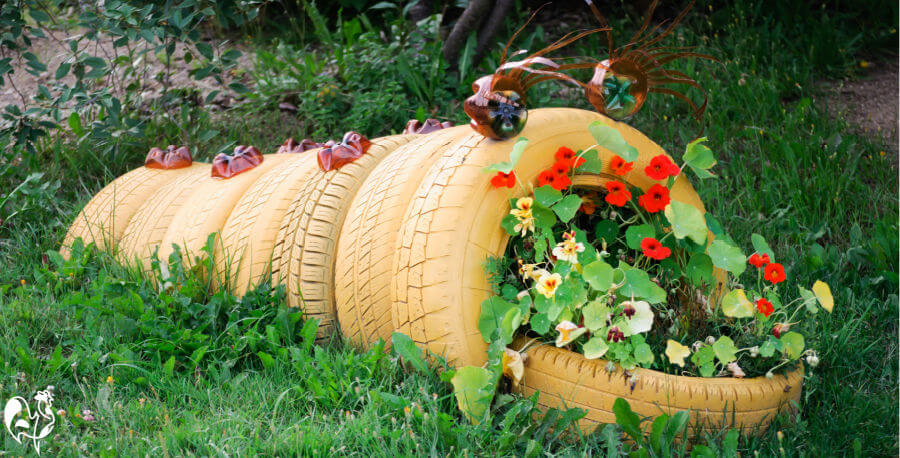 This clever planter looks nice, but if allowed, chickens will dig those nasturtiums up in seconds!
This clever planter looks nice, but if allowed, chickens will dig those nasturtiums up in seconds!Growing nasturtiums.
Nasturtium seeds.
Two or three nasturtium seeds form on each plant when the flower dies. They're very versatile: they can be eaten, or used as seeds from which new plants can be grown the following year.
- For eating, harvest them as soon as the flowers fall. Either dry them naturally and grind into a natural pepper, or pickle them without drying as a substitute for capers.
- For growing new plants, either collect when green and allow to dry naturally in the open air, or leave until they're brown and fallen from the plant.
- Save the dried seeds in a sealed envelope in a cool, dry place to grow into new plants next year. If you leave the seeds on the ground some will grown naturally into new plants the following year.
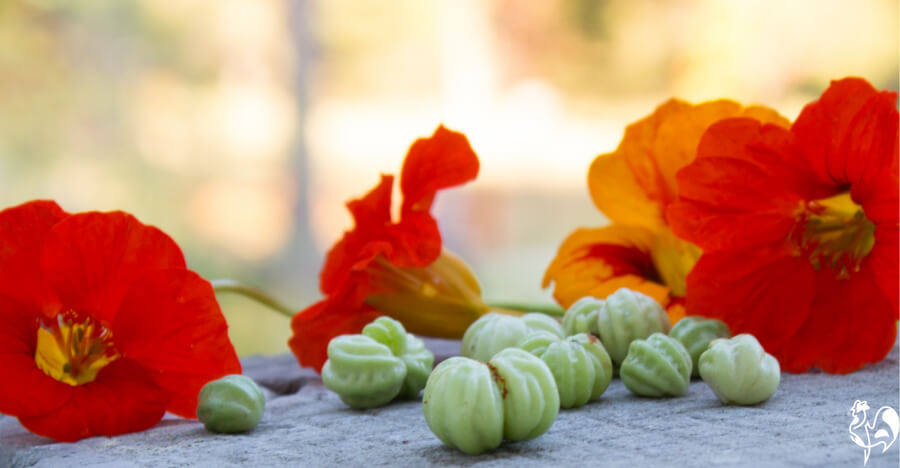 Nasturtium seeds: eat them or use to grow more nasturtiums!
Nasturtium seeds: eat them or use to grow more nasturtiums!Sowing the seeds.
- The nasturtium can grow in either shade or sun. If the patch gets very hot sun, find a little shade instead. Or plant between veggies to attract pests - but be aware you're probably sacrificing the nasturtium itself.
- The seeds can be planted directly into the ground, once the danger of frost has passed. Sow them 2.5cm (one inch) down - they need darkness to germinate.
- Water them regularly until they start to come into leaf. Once established they don't need much water.
- If you want larger plants to get a head start with summer flowering, or if you're afflicted with slugs which will eat young plants, plant indoors until they're well established. The seeds are large enough to sow in individual pots.
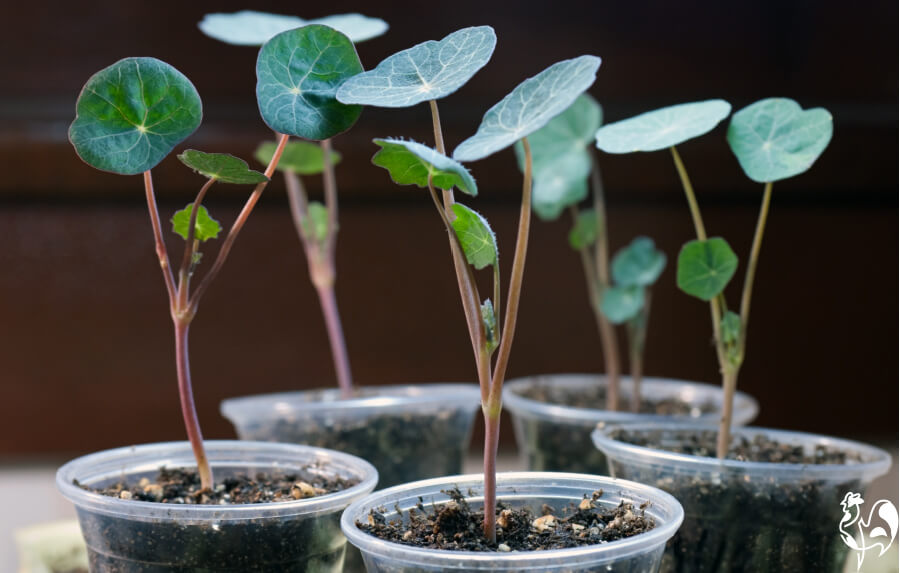
How to prune nasturtiums.
They really need very little care once the plant is established.
- When planting out your seedlings, if you've grown them indoors, wait till frosts have gone and don't add nutrients to the soil. You'll have more flowers from a poor, dry soil.
- If the plants start to look a little "leggy", cut back and put the leaves and vines on the compost heap. The chickens will eat the leaves but tend to avoid the vines themselves if they're not very tender.
- How often to water? If you have any rainfall during the growing period, you may not need to water at all. If your area is very arid water sparsely, once a week.
- Sometimes the leaves turn yellow. This generally means they're being either under- or over-watered. Whichever you're doing, do the opposite!
How to feed the edible parts of the nasturtium to chickens.
It's not difficult...
- Steeping a cupful of leaves in boiling water makes a nasturtium tea. Try adding this to your chickens' water in the summer as an instant Vitamin "C" boost.
- Cut some stems from plants you have in your pots or garden and throw them into the chicken run. Chickens can eat the flowers, leaves and stems, so there's no need to separate them.
- They'll prefer the plants when they're young and tender - chickens can be picky when it comes to food!
- Pick the leaves when they're still small. If you don't want to feed them to your flock straight away, keep them in a sealed bag in your fridge for up to 5 days.
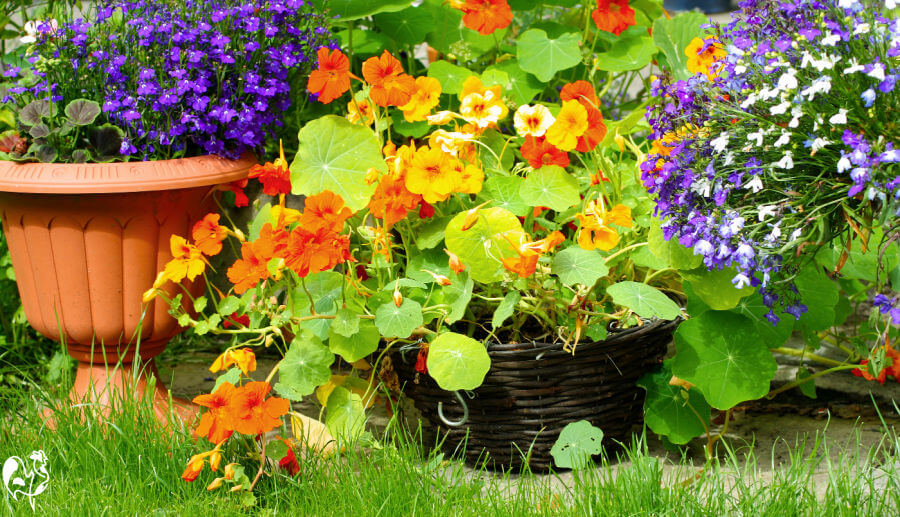 Sacrifice your displays - feed the nasturtiums to your chickens!
Sacrifice your displays - feed the nasturtiums to your chickens!More about what's good for chickens to eat.
Sources.
1. Tabler, T., et al: Fowl pox in backyard flocks. Pub. Mississippi State University Extension Service, 2017.
2. Brosell, H.: Active substances from higher native flowering plants and their use as growth stimulants in the feeding of young poultry. Pub. 1958.
3. Jakubczyk, K, et al: Garden nasturtium (Trapaeolum majus) - a source of mineral elements and bioactive compounds. Pub. 2018.
4. Bhuiyan, A., et al: Importance of vitamin A supplementation for performance of chickens under smallholder farm conditions. Pub. Department of Animal Nutrition and Physiology, Danish Institute of Agricultural Sciences, 2004.
5. Byoung-Ke, A et al: the tissue distribution of lutein in laying hens fed lutein fortified chlorella and production of chicken eggs enriched with lutein. pub. Korean Journal for Food Science of Animal Resources, 2014.
6. Niizu, P. and Rodriguez Amaya, D.: Flowers and leaves of Tropaeolum majus as rich sources of lutein. Pub. Journal of Food Science, 2005.
- Home
- Plants for Chickens
- Nasturtiums
